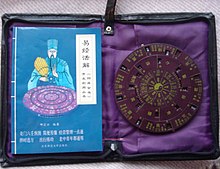This article has multiple issues. Please help improve it or discuss these issues on the talk page. (Learn how and when to remove these messages)
|
Qimen Dunjia is an ancient form of divination from China. It is still in use in mainland China, Taiwan, Hong Kong, Macau, Malaysia, Singapore and the Chinese diaspora in Southeast Asia.[citation needed] It is one of the Three Styles (三式; sānshì; 'three styles') of Chinese divination, with Da Liu Ren and Tai Yi Shen Shu.
| Qimen Dunjia | |||||||
|---|---|---|---|---|---|---|---|
| Traditional Chinese | 奇門遁甲 | ||||||
| Simplified Chinese | 奇门遁甲 | ||||||
| Literal meaning | Mysterious gates escape technique | ||||||
| |||||||

History
editOriginally devised to help form military strategy and tactics, Qimen Dunjia was in use as long ago as the period of Chinese history known as the Warring States, and is believed by Chinese scholars to have been used at the Battle of Red Cliffs in the defeat of Cao Cao's ship-borne army.
Liu Bowen is believed to have secured the throne for the Ming dynasty Emperor Hongwu by applying Qimen Dunjia to his strategic planning.
Over the centuries of Chinese history, Qimen Dunjia grew in popularity and was expanded to include a number of other types of divination, including medical divination, matchmaking, childbirth, travel, personal fortunes, and today includes contemporary applications, most notably that of business and finance. Today Qimen Dunjia is especially popular in Singapore and other nations of Southeast Asia.
Technique
editQimen Dunjia is based on astronomical observations, and consists of various aspects of Chinese metaphysics, including the doctrines of yin and yang, five elements, the eight trigrams, the ten Heavenly Stems and the twelve Earthly Branches, as well as the twenty-four solar terms.
The Qimen Dunjia cosmic board consists of a 3 × 3 magic square of nine palaces (九宮), which includes a Heaven and Earth plate, a spirit plate, eight gates and a star plate. The various symbols rotate around the palaces with each double-hour of the day, making a total of 1,080 different configurations of the Qimen Dunjia cosmic board. These situations (局; jú) are recycled four times per year, and are divided between the Yin and Yang halves of the year.
Each type of Qimen Dunjia divination carries its unique set of Use Spirits (用神; yòngshén). For example, medical divination relies mainly upon the star plate. The task of the Qimen Dunjia analyst is to interpret and analyze the meanings of the symbols in relation to questions asked. Any Qimen Dunjia situation may be interpreted or analyzed to respond to a wide variety of questions, or to solve a multitude of problems. Examples of questions include understanding the underlying objective of the other party in a situation, looking for missing objects, and analyzing cause and effects.
Qimen Dunjia is time-sensitive. The analyst makes reference to the configuration of the cosmic board at the time when a question is posed, or for birth times of individuals or corporate entities, such as businesses or nations. At times, the same or very similar configurations of the cosmic board will appear in relation to the same series of questions or problems.
See also
edit- Chinese astrology
- Chinese astronomy
- Chinese classical texts
- Da Liu Ren
- Feng shui
- Flying Star Feng Shui
- Hypernumbers
- I Ching & I Ching divination
- Wen Wang Gua
- Jiaobei & Poe divination
- Kau Cim
- Jiutian Xuannü, Powerful female Deity in Chinese folk religion
- Shaobing Song
- Tai Yi Shen Shu
- Tie Ban Shen Shu
- Tui bei tu
- Tung Shing
- Yuan Hai Zi Ping
Further reading
edit- Ho Peng Yoke (2013) [2003]. "Qimen Dunjia: Strange Gates, Escaping Techniques". Chinese mathematical astrology: reaching out to the stars. Routledge. ISBN 9780415863100.
- Li, Yang (1998). Book of Changes And Traditional Chinese Medicine. Beijing Science and Technology Press. ISBN 9787530420256.
- 杜新会 (Dun Xinhui) (2003). qímén dùnjiǎ xiàndài shílì jīng jiě 奇门遁甲现代实例精解 [Qimen Dunjia in the modern era: real examples, precise solutions]. Kuitun: 伊犁人民出版社. OCLC 930808057.
External links
edit- "九天上聖秘傳金符經". Archived from the original on 2013-04-19. Retrieved 2019-01-02.